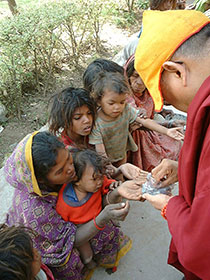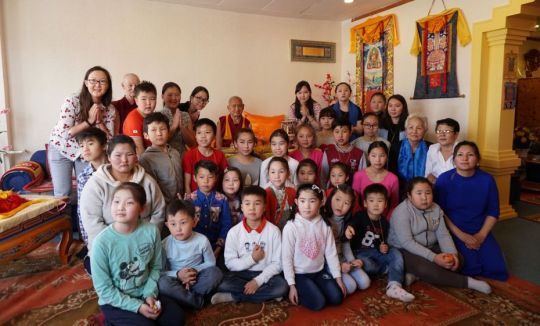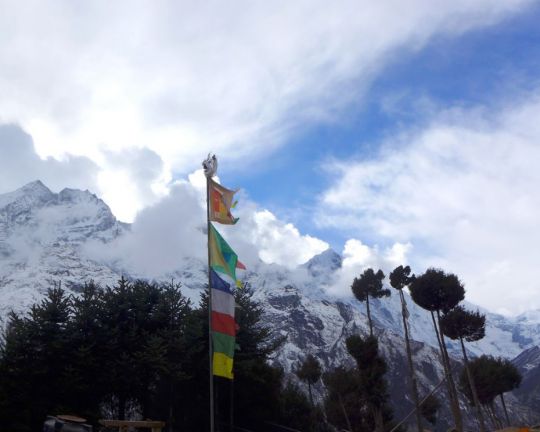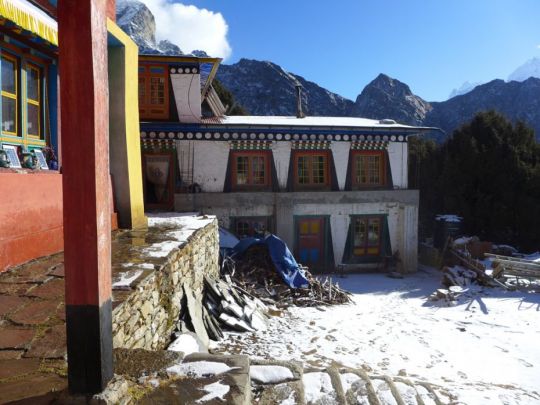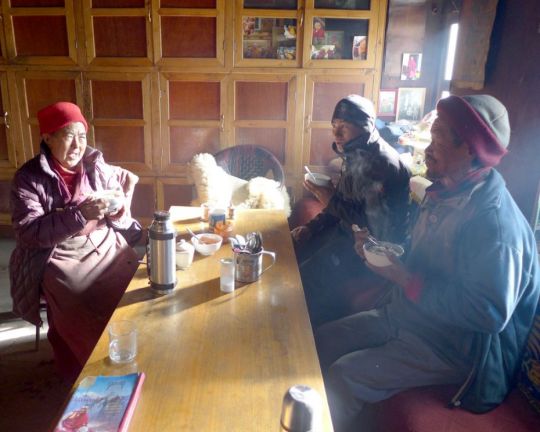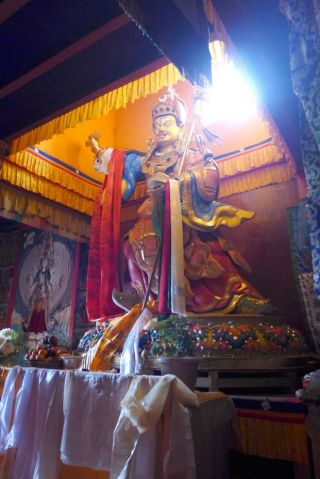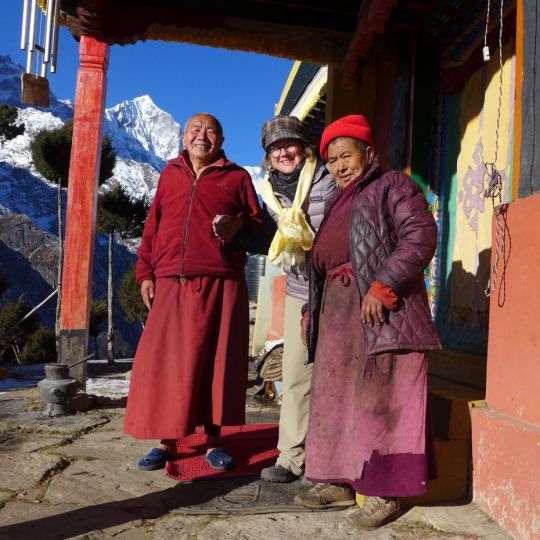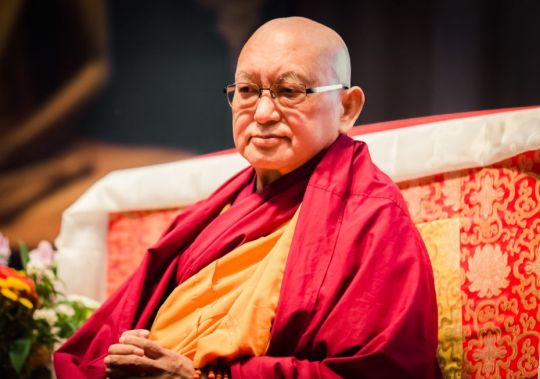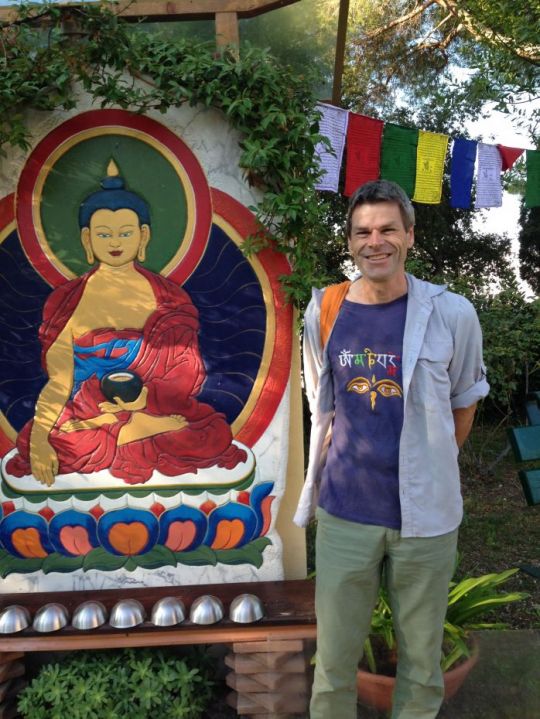- Home
- FPMT Homepage

Foundation for the Preservation of the Mahayana Tradition
The FPMT is an organization devoted to preserving and spreading Mahayana Buddhism worldwide by creating opportunities to listen, reflect, meditate, practice and actualize the unmistaken teachings of the Buddha and based on that experience spreading the Dharma to sentient beings. We provide integrated education through which people’s minds and hearts can be transformed into their highest potential for the benefit of others, inspired by an attitude of universal responsibility and service. We are committed to creating harmonious environments and helping all beings develop their full potential of infinite wisdom and compassion. Our organization is based on the Buddhist tradition of Lama Tsongkhapa of Tibet as taught to us by our founders Lama Thubten Yeshe and Lama Thubten Zopa Rinpoche.
- Willkommen
Die Stiftung zur Erhaltung der Mahayana Tradition (FPMT) ist eine Organisation, die sich weltweit für die Erhaltung und Verbreitung des Mahayana-Buddhismus einsetzt, indem sie Möglichkeiten schafft, den makellosen Lehren des Buddha zuzuhören, über sie zur reflektieren und zu meditieren und auf der Grundlage dieser Erfahrung das Dharma unter den Lebewesen zu verbreiten.
Wir bieten integrierte Schulungswege an, durch denen der Geist und das Herz der Menschen in ihr höchstes Potential verwandelt werden zum Wohl der anderen – inspiriert durch eine Haltung der universellen Verantwortung und dem Wunsch zu dienen. Wir haben uns verpflichtet, harmonische Umgebungen zu schaffen und allen Wesen zu helfen, ihr volles Potenzial unendlicher Weisheit und grenzenlosen Mitgefühls zu verwirklichen.
Unsere Organisation basiert auf der buddhistischen Tradition von Lama Tsongkhapa von Tibet, so wie sie uns von unseren Gründern Lama Thubten Yeshe und Lama Thubten Zopa Rinpoche gelehrt wird.
- Bienvenidos
La Fundación para la preservación de la tradición Mahayana (FPMT) es una organización que se dedica a preservar y difundir el budismo Mahayana en todo el mundo, creando oportunidades para escuchar, reflexionar, meditar, practicar y actualizar las enseñanzas inconfundibles de Buda y en base a esa experiencia difundir el Dharma a los seres.
Proporcionamos una educación integrada a través de la cual las mentes y los corazones de las personas se pueden transformar en su mayor potencial para el beneficio de los demás, inspirados por una actitud de responsabilidad y servicio universales. Estamos comprometidos a crear ambientes armoniosos y ayudar a todos los seres a desarrollar todo su potencial de infinita sabiduría y compasión.
Nuestra organización se basa en la tradición budista de Lama Tsongkhapa del Tíbet como nos lo enseñaron nuestros fundadores Lama Thubten Yeshe y Lama Zopa Rinpoche.
A continuación puede ver una lista de los centros y sus páginas web en su lengua preferida.
- Bienvenue
L’organisation de la FPMT a pour vocation la préservation et la diffusion du bouddhisme du mahayana dans le monde entier. Elle offre l’opportunité d’écouter, de réfléchir, de méditer, de pratiquer et de réaliser les enseignements excellents du Bouddha, pour ensuite transmettre le Dharma à tous les êtres. Nous proposons une formation intégrée grâce à laquelle le cœur et l’esprit de chacun peuvent accomplir leur potentiel le plus élevé pour le bien d’autrui, inspirés par le sens du service et une responsabilité universelle. Nous nous engageons à créer un environnement harmonieux et à aider tous les êtres à épanouir leur potentiel illimité de compassion et de sagesse. Notre organisation s’appuie sur la tradition guéloukpa de Lama Tsongkhapa du Tibet, telle qu’elle a été enseignée par nos fondateurs Lama Thoubtèn Yéshé et Lama Zopa Rinpoché.
Visitez le site de notre Editions Mahayana pour les traductions, conseils et nouvelles du Bureau international en français.
Voici une liste de centres et de leurs sites dans votre langue préférée
- Benvenuto
L’FPMT è un organizzazione il cui scopo è preservare e diffondere il Buddhismo Mahayana nel mondo, creando occasioni di ascolto, riflessione, meditazione e pratica dei perfetti insegnamenti del Buddha, al fine di attualizzare e diffondere il Dharma fra tutti gli esseri senzienti.
Offriamo un’educazione integrata, che può trasformare la mente e i cuori delle persone nel loro massimo potenziale, per il beneficio di tutti gli esseri, ispirati da un’attitudine di responsabilità universale e di servizio.
Il nostro obiettivo è quello di creare contesti armoniosi e aiutare tutti gli esseri a sviluppare in modo completo le proprie potenzialità di infinita saggezza e compassione.
La nostra organizzazione si basa sulla tradizione buddhista di Lama Tsongkhapa del Tibet, così come ci è stata insegnata dai nostri fondatori Lama Thubten Yeshe e Lama Zopa Rinpoche.
Di seguito potete trovare un elenco dei centri e dei loro siti nella lingua da voi prescelta.
- 欢迎 / 歡迎
简体中文
“护持大乘法脉基金会”( 英文简称:FPMT。全名:Foundation for the Preservation of the Mahayana Tradition) 是一个致力于护持和弘扬大乘佛法的国际佛教组织。我们提供听闻,思维,禅修,修行和实证佛陀无误教法的机会,以便让一切众生都能够享受佛法的指引和滋润。
我们全力创造和谐融洽的环境, 为人们提供解行并重的完整佛法教育,以便启发内在的环宇悲心及责任心,并开发内心所蕴藏的巨大潜能 — 无限的智慧与悲心 — 以便利益和服务一切有情。
FPMT的创办人是图腾耶喜喇嘛和喇嘛梭巴仁波切。我们所修习的是由两位上师所教导的,西藏喀巴大师的佛法传承。
繁體中文
護持大乘法脈基金會”( 英文簡稱:FPMT。全名:Found
ation for the Preservation of the Mahayana Tradition ) 是一個致力於護持和弘揚大乘佛法的國際佛教組織。我們提供聽聞, 思維,禪修,修行和實證佛陀無誤教法的機會,以便讓一切眾生都能 夠享受佛法的指引和滋潤。 我們全力創造和諧融洽的環境,
為人們提供解行並重的完整佛法教育,以便啟發內在的環宇悲心及責 任心,並開發內心所蘊藏的巨大潛能 — 無限的智慧與悲心 – – 以便利益和服務一切有情。 FPMT的創辦人是圖騰耶喜喇嘛和喇嘛梭巴仁波切。
我們所修習的是由兩位上師所教導的,西藏喀巴大師的佛法傳承。 察看道场信息:
- FPMT Homepage
- News/Media
-
- Study & Practice
-
-
- About FPMT Education Services
- Latest News
- Programs
- New to Buddhism?
- Buddhist Mind Science: Activating Your Potential
- Heart Advice for Death and Dying
- Discovering Buddhism
- Living in the Path
- Exploring Buddhism
- FPMT Basic Program
- FPMT Masters Program
- FPMT In-Depth Meditation Training
- Maitripa College
- Lotsawa Rinchen Zangpo Translator Program
- Universal Education for Compassion & Wisdom
- Online Learning Center
-
- Prayers & Practice Materials
- Overview of Prayers & Practices
- Full Catalogue of Prayers & Practice Materials
- Explore Popular Topics
- Benefiting Animals
- Chenrezig Resources
- Death & Dying Resources
- Lama Chopa (Guru Puja)
- Lama Zopa Rinpoche: Compendium of Precious Instructions
- Lama Zopa Rinpoche: Life Practice Advice
- Lama Zopa Rinpoche Practice Series
- Lamrim Resources
- Mantras
- Prayer Book Updates
- Purification Practices
- Sutras
- Thought Transformation (Lojong)
- Audio Materials
- Dharma Dates - Tibetan Calendar
- Translation Services
- Publishing Services
- Ways to Offer Support
- Prayers & Practice Materials
-
- Teachings and Advice
- Find Teachings and Advice
- Lama Zopa Rinpoche Advice Page
- Lama Zopa Rinpoche: Compendium of Precious Instructions
- Lama Zopa Rinpoche Video Teachings
- ༧སྐྱབས་རྗེ་བཟོད་པ་རིན་པོ་ཆེ་མཆོག་ནས་སྩལ་བའི་བཀའ་སློབ་བརྙན་འཕྲིན།
- Podcasts
- Lama Yeshe Wisdom Archive
- Buddhism FAQ
- Dharma for Young People
- Resources on Holy Objects
- Teachings and Advice
-
-
*If a menu item has a submenu clicking once will expand the menu clicking twice will open the page.
-
-
- Centers
-
- Teachers
-
- Projects
-
-
-
-
*If a menu item has a submenu clicking once will expand the menu clicking twice will open the page.
-
-
- FPMT
-
-
-
-
-
Buddhist meditation doesn’t necessarily mean sitting cross-legged with your eyes closed. Simply observing how your mind is responding to the sense world can be a really perfect meditation and bring a perfect result.
Lama Thubten Yeshe
-
-
-
- Shop
-
-
-
The Foundation Store is FPMT’s online shop and features a vast selection of Buddhist study and practice materials written or recommended by our lineage gurus. These items include homestudy programs, prayers and practices in PDF or eBook format, materials for children, and other resources to support practitioners.
Items displayed in the shop are made available for Dharma practice and educational purposes, and never for the purpose of profiting from their sale. Please read FPMT Foundation Store Policy Regarding Dharma Items for more information.
-
-
FPMT News Around the World
31
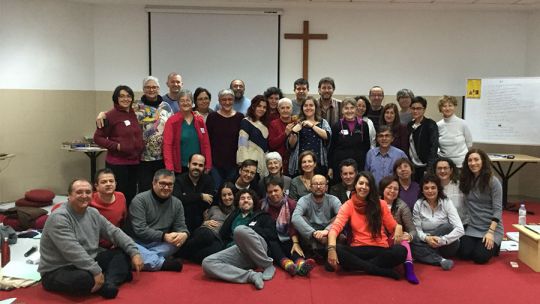
Attendees of the Foundation Service Seminar near Madrid, Spain, December 2017. Photo courtesy of Paloma Fernandez.
In December 2017, a Foundation Service Seminar (FSS) was held near Madrid. Organized and facilitated by Spain national coordinator Paloma Fernandez and senior facilitator and center director François Lecointre, this was the first FSS to be held entirely in Spanish. Paloma shares news from the event:
Last December, we had our first Foundation Service Seminar in Spain, the first time that the seminar has been done in Spanish.
Thirty-eight people came from many different parts of Spain, and one person traveled all the way from London, to participate in the event. People arrived by all means: planes, trains, and buses. Many of them used five vacation days to attend this seminar and dedicate their time to the FPMT and Lama Zopa Rinpoche.
François Lecointre, a senior FSS registered facilitator and director of Institut Vajra Yogini, offered his time, his experience, his knowledge, his kindness, and love to all the participants. (And to me, as I was co-facilitating the seminar for the first time!)
We started every day after breakfast. Each day offered different learning activities, which typically ran until 10 p.m. each night. It was a quite intense schedule, but nobody complained. It was a great experience!
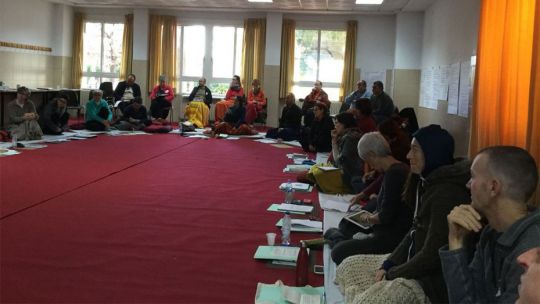
A group activity during the Foundation Service Seminar near Madrid, Spain, December 2017. Photo courtesy of Paloma Fernandez.
We all worked with great focus, analyzing different aspects of our service. We had people from nine different centers, one study group, one community project, and one from Universal Education. It was very enriching to have so many different experiences and points of view to share and to learn from.
As well as the dynamic group exercises, we also had a number of beautiful meditations, great presentations, and very stimulating discussions. We also watched very inspiring videos from Lama Zopa Rinpoche, Lama Yeshe, and Tenzin Ösel Hita.
The main highlight for most of us was, as Lama Yeshe used to say, the “family feeling” that was present during all the seminars. It was so great to be able to share five days and nights with the FPMT family and to experience what it means to be the “ambassadors” of His Holiness the Dalai Lama and Lama Zopa Rinpoche.
One question that came from many participants was: “When is the next one?” So I have the feeling that this is the sign that the first FSS in Spain was a great success!
Foundation Service Seminar events are happening this year in Mexico in early February; at Jamyang Buddhist Centre, UK, in August; and at Milarepa Center, USA, in September. For more information on the Foundation Service Seminar and to find out how to register for future events, visit the FPMT Service Seminar webpage.
Mandala brings you news of Lama Zopa Rinpoche and of activities, teachings and events from nearly 160 FPMT centers, projects and services around the globe. If you like what you read on Mandala, consider becoming a Friend of FPMT, which supports our work.
24
The Mahayana Children’s Programme, a program of FPMT Mongolia, is now celebrating its tenth anniversary. To mark the occasion, FPMT Mongolia director Ianzinha Bartanova shared a video of the children, recorded in Ulaanbaatar, the nation’s capital. Ianzinha writes the following about the video and the Mahayana Children’s Programme:
In the video below the youngest group of the Mahayana Children’s Programme participants, ranging in age from six to eight years, happily recite mantras in Mongolian and dedicate all merit from their practice to Lama Zopa Rinpoche’s long life.
Before they commence the mantra recitation, the children generate the correct motivation as follows: “I will do these recitations in order to be beneficial to my country, and all the six-realm sentient beings, and for my family, and myself to be happy, and to have good qualities such as perseverance, patience, responsibility, and friendliness.”
Currently practicing memorization, the children wholeheartedly enjoy the recitation of the following mantras and prayers: Guru Shakyamuni Buddha, Chenrezig, Manjushri, Vajrapani, the prostration mantra, Tara, Medicine Buddha, Vajrasattva, the mantra to bless offerings, and Migtsema.
As the children have a deep appreciation for the importance of dedication in practice, they concluded with these wishes: “Due to these merits collected, may I and my family be happy! May the most precious and kind Lama Zopa Rinpoche have a long and healthy life, and may Rinpoche lead us in all future lives!”
On behalf of all FPMT Mongolia staff and students, we would like to join with the children and dedicate all our merits accumulated during 2017 for Rinpoche’s long, healthy, and stable life. We rejoice in all meritorious actions done by the FPMT family, and from the bottom of our hearts, we wish you all a very happy and prosperous new year!
Learn more about the work of FPMT in Mongolia: http://www.fpmtmongolia.org
Learn more about the Mahayana Children’s Programme:
http://www.fpmtmongolia.org/mahayana-childrens-programme
FPMT.org and Mandala Publications brings you news of Lama Zopa Rinpoche and of activities, teachings and events from over 160 FPMT centers, projects and services around the globe. If you like what you read, consider becoming a Friend of FPMT, which supports our work.
- Tagged: fpmt mongolia, mahayana childrens program
17
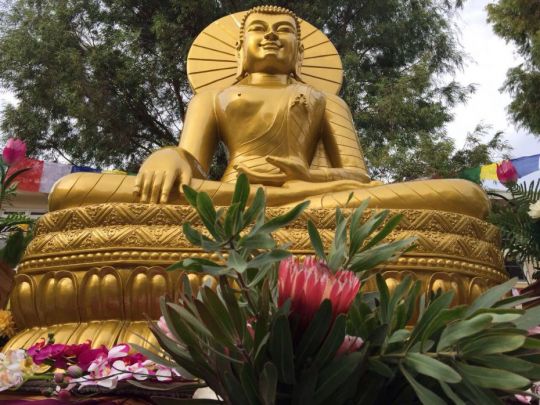
Buddha statue prior to offering gold-leaf at the Guru bumtsog, Hobart, Tasmania, June 2016. Photo courtesy of Stephanie Brennan.
In June 2017, FPMT in Australia (FPMTA) and Chag Tong Chen Tong Tibetan Buddhist Centre (CTCT) organized 100,000 tsog offerings to Guru Rinpoche, also known as a “Guru bumtsog.” More than 160 students from twenty or so Australian FPMT centers, projects, and services traveled to Hobart, Tasmania, to take part in the powerful and joyous multi-day event.
In a new Mandala online feature, “The Power of Guru Rinpoche: The Heart-Opening Guru Bumtsog Experience,” Stephanie Brennan, FPMTA National Education/Tour Coordinator, shares her personal account of the Guru bumtsog experience.
“… After chai and cake were served, the first puja session began. With eighteen Sangha present from all over Australia, the gompa was filled with maroon and saffron robes. Sitting in front were two geshes—Geshe Tenzin Zopa, who led the puja, and Geshe Phuntsok Tsultrim, the resident geshe at Chenrezig Institute, Queensland. Also in front was Lama Jimay from Tasmania, who ably assisted with the hook drum,” Stephanie writes.
“In the first session, we started by chanting the full verses of the ‘Prayer to Guru Rinpoche That Spontaneously Fulfills All Wishes’ to a poignant and melodic tune. This was followed by the tsog offering prayer and Guru Rinpoche mantra, which were repeated many times. These repetitions were accompanied by cymbals and drums with a very stirring beat. As the pace of these repetitions was fast, it took a little while for everyone to get their head around the Tibetan syllables, but soon everyone settled into a kind of rhythm, with Geshe Tenzin Zopa’s clear voice leading us forward.
“Sangha members played the ritual instruments, and the gompa became warm and energized. As I looked at the large thangka of Guru Rinpoche above the tsog offerings, it felt to me that evoking the spirit of Guru Rinpoche and knowing that this puja had been blessed by Lama Zopa Rinpoche beforehand, particularly to clear obstacles, made everything in the gompa seem timeless, vivid, and very clear. …”
Read Stephanie Brennan’s article “The Power of Guru Rinpoche: The Heart-Opening Australian Guru Bumtsog Experience” in its entirety:
https://fpmt.org/mandala/in-depth-stories/the-power-of-guru-rinpoche-the-heart-opening-australian-guru-bumtsog-experience
FPMT.org and Mandala Publications brings you news of Lama Zopa Rinpoche and of activities, teachings, and events from over 160 FPMT centers, projects and services around the globe. If you like what you read, consider becoming a Friend of FPMT, which supports our work.
3
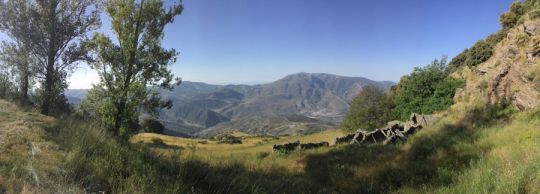
Mountain view from Oseling Retreat Center, October 2017. Photo courtesy of Oseling Retreat Center.
Oseling Retreat Center, in the Andalusia region of Spain, has undertaken a new project. In response to advice from Lama Zopa Rinpoche, the center has begun work on the planning, construction, and fund-raising aspects for a new nunnery that will provide a home and learning facility for European nuns. Center director Anne Wenaas describes the project for Mandala:
Lama Zopa Rinpoche advised Oseling Retreat Center in Spain to establish a nunnery within its grounds. In keeping with Rinpoche’s vision, construction has recently commenced on a project that promises to provide a “powerhouse of Dharma practice” for European nuns.
It is of great importance for all the nuns to have a place to live, so that they can observe a monastic life and dedicate their lives to study, contemplation, and meditation. The living costs for each nun will be very low, only food and maintenance will be needed.
Oseling is situated in the Sierra Nevada, a mountain range about forty kilometers (twenty-five miles) from the coast and within traveling distance of the city of Granada. The center is quite high up the mountains, forming a large portion of the top of a mountain within the National Park.
If you are familiar with Oseling, the location of the nunnery will be just below the Tara statue, a wonderful place with a wide view of the whole valley. Construction of the nunnery has recently begun.

Architect’s drawing of the proposed nunnery at Oseling. Image courtesy of Oseling Retreat Center.
This is a very beneficial project, and practitioners at the center will all have a great and unique opportunity to help realize Rinpoche’s ambition. They encourage everyone to participate and hope to quickly raise the funds necessary to finish construction.
It is the center’s hope that Tara’s prayer will inspire the future community of nuns:
“There are many who desire Enlightenment in a man’s body, but none who works for the benefit of the sentient beings in the body of a woman. Therefore, until samsara is empty, I shall work for the benefit of sentient beings in a female body.”
Developments of the construction project will be shared via the Oseling Facebook page.
For more information or to offer support, please contact Oseling via their email: oficina@oseling.com
More information, photos, and updates about FPMT spiritual director Lama Zopa Rinpoche can be found on Rinpoche’s webpage on FPMT.org. If you’d like to receive news of Lama Zopa Rinpoche and FPMT via email, sign up to FPMT News.
- Tagged: osel nunnery, oseling retreat center
27
Lawudo Retreat Centre, located in the Solu Khumbu district of Nepal, is where FPMT spiritual director Lama Zopa Rinpoche’s previous incarnation meditated and not far from the village where Rinpoche was born. Mandala editor Laura Miller visited Lawudo in early 2017 and shared this reflection on her experience there.
Visiting Lawudo, high in the Himalayan mountains of Nepal, had been a wish of mine for nearly eight years. And on New Year’s day 2017, my tired legs trudged up the final steep path and carried me into the yard in front of the Lawudo Gompa. Lama Zopa Rinpoche’s sister, Ani Ngawang Samten, stood there as I approached. Tears formed in my eyes when I took her hands, which seemed so soft to me despite five decades of tireless work looking after the holy retreat site. All I could say to her was how happy I was to finally be there. The previous year, my sense of personal accomplishment had sunk to a difficult low. But there I was, standing just under 13,000 feet [4,000 meters], in a place surrounded by gorgeous mountains and graced by highly accomplished practitioners. Just being there, I had achieved something that felt profoundly worthwhile and a little adventurous.
Before starting my trek to Lawudo, I’d read The Lawudo Lama, an invaluable book by Ven. Jamyang Wangmo that tells the story of the inspiring lives of Lawudo Lama Kunzang Yeshe and his reincarnation Lama Zopa Rinpoche, as well as offers a detailed description of the religious and cultural history of the Mount Everest region, where Lawudo is situated. As my Sherpa guide Nursang and I walked over several days up the trail from the airstrip in Lukla to Namche Bazaar to Thame, Lama Zopa Rinpoche’s birthplace, and finally to Lawudo, the mani stones, prayer wheels, stupas, and gompas created endless opportunities for receiving blessings, rejoicing, and contemplating how generations of Sherpas, who populate the area, had made Dharma practice integral to daily life.
I can date the origin of my trip back to the time when I did a little volunteer work for Mandala magazine. While working on something for the former editor, I visited the website for Lawudo Retreat Centre. The thought “I want to go there” shot directly through my mind as I scrolled through photos of the cave where the Lawudo Lama meditated and of the Lawudo Gompa and the mountains and valley that surround them. During the past six years that I’ve worked as the editor of Mandala, I’ve read and re-read stories about Lawudo: the early years when Lama Yeshe and Rinpoche visited; the young boys who became the first Kopan monks; the experiences of Westerner students who traveled there to practice; and Ani Ngawang Samten, who still keeps it all going. When the earthquake devastated Nepal in 2015, I, along with many, many others, anxiously awaited news of what happened in Lawudo.
Fortunately, Lawudo survived and everyone there was OK. When my opportunity came to visit, like so many before me, I spent many happy hours in Ani-la’s smoky kitchen. I intently ate her nourishing food and listened to her first-hand stories of the early days and to her concerns about the always tenuous water supply and what will happen to Lawudo when she can no longer take care of it. That said, Ani-la didn’t seem to care much to talk about the earthquake. The building that contains the kitchen, dining room, and her own room, received significant damage, as did several other buildings, including the gompa and library. She lived in a tent for months while repairs were being made. During my visit, it appeared that most of the major repairs had been done thanks to generous support from the Nepal Earthquake Support Fund.
The story I enjoyed most from Ani-la recounted the fraught, weeks-long effort to bring the very large Guru Rinpoche statue up to Lawudo and into the gompa. There are no roads in the upper Solu Khumbu district. Humans and yaks carry all nature of things in this remote area; helicopters bring in larger goods and shipments. The beautiful Guru Rinpoche statue stands 13.5 feet [14 meters] tall, far too large to be carried very far. In fact, it is so tall that part of the ceiling of the gompa had to be removed in order for it to fit. My retelling of Ani-la’s story wouldn’t do it justice, but her account covered a succession of false starts, involving a very big helicopter, bad weather, drunken pilots, and the statue being stuck inside the helicopter until it wasn’t. The story ended with an auspicious rainbow surrounding the helicopter on its arrival at Mende, just below Lawudo, and the two dozen Sherpas who carried the precious holy object up the steep hill and into the gompa. The Padmasambhava Project for Peace covered the cost of inviting this impressive statue to Lawudo as well as its creation and that of nine other smaller statues of Guru Rinpoche that are now in the Lawudo Gompa.
My visit to Lawudo was short, just a taste. I had one afternoon to meditate in the Lawudo Lama’s cave. But like receiving even a short Dharma teaching from a Buddhist master, that experience had a deep and lasting effect. Thinking about it now, the dollars spent, the hard work of the hike up, the rough accommodations, and the misgivings about the elevation and the state of my body all seem so minuscule when I compare them to simply being able to be in that cave. I hope and dedicate that anyone else who wishes to go to Lawudo be able to do so and that I am able to return. I rejoice and am grateful for all who have supported the Lawudo Retreat Centre over the years and pray that it may continue on for a very long time.
The author thanks Effie Fletcher at Himalayan High Treks and Dharma Journeys Pilgrimages, and Amber Tamang at Three Jewels Adventures for their help with arrangements for the trek.
FPMT.org brings you news of Lama Zopa Rinpoche and of activities, teachings and events from over 160 FPMT centers, projects and services around the globe. If you like what you read, consider becoming a Friend of FPMT, which supports our work.
- Tagged: lawudo, lawudo retreat centre, nepal earthquake support fund, padmasambhava project for peace
29
In September of this year, Lama Zopa Rinpoche visited Panchen Losang Chogyen Gelugzentrum (PLC) in Austria. This was Rinpoche’s first official visit and the first opportunity for Austrian students to attend teachings, receive an initiation, and to take refuge from Rinpoche. Center director Stefan Seidler shares a brief overview of Rinpoche’s time in Vienna:
In September, Lama Zopa Rinpoche arrived for the first time in Vienna. Many of us are still feeling the presence of our precious guru in our hearts and minds.
From the very first moments at the airport, where spiritual program coordinator Andrea Husnik, myself, and many students from Panchen Losang Chogyen Gelugzentrum welcomed him, everybody felt Rinpoche‘s incredible kindness, generosity, and the warmth of heart.
After one night in a hotel, Rinpoche and his entourage moved into a wonderful old house in a quiet area in the north of Vienna, where they would stay for the next two weeks and which had been offered very generously by the parents of one of PLC’s board members.
Hard work was required to prepare the house for so many visitors, and the benefits everybody received from Rinpoche have been enormous. He was so kind to share much of his precious time with the host family, even learning how to make apple strudel. Rinpoche’s mere presence—his wisdom, his laugh, his never-ending kindness to everyone in the house—gave them all so much inspiration that every domestic task became a pure joy.
Also during the visit, all of the center’s board members and main volunteers had the opportunity to spend time with Rinpoche. As almost none of the center members in Vienna had met Rinpoche before, this visit was an amazing and rare opportunity for all of them. A very nice dinner for board members and volunteers was held in Vienna’s city center, and a wonderful, inspiring private visit to the center itself prepared us all for the big weekend to come.
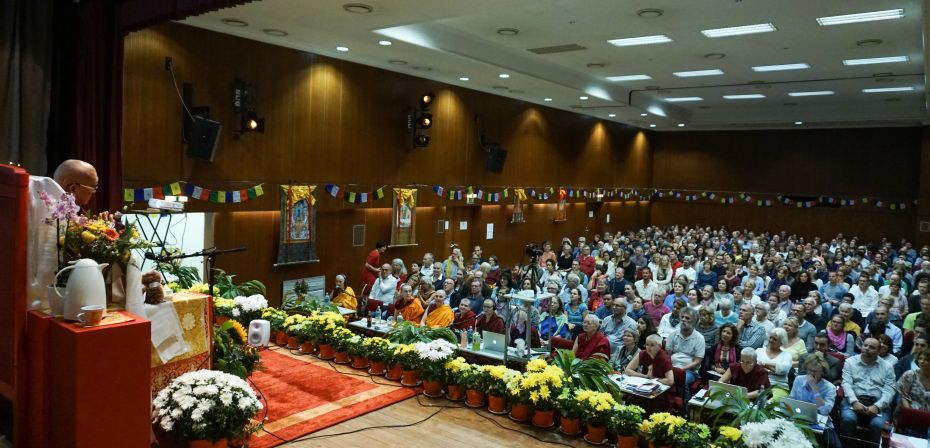
Lama Zopa Rinpoche teaching in Vienna, Austria, September 2017. Photo courtesy of Ven. Sherab.
Almost 400 people registered and the venue, which we had rented, was fully packed for all three days. Besides people from Austria and Germany, many others traveled from all over Europe to visit Vienna. We had guests from Spain, the UK, the Czech Republic, Switzerland, France, Italy and many more countries, all eager to attend Rinpoche’s teachings.
Rinpoche’s teachings were amazing. With the help of transcriber Ven. Joan Nicell and translators Ven. Birgit Schweiberer and Ven. Paloma Alba, we were able to understand Rinpoche’s limitless wisdom.
After the teachings, Rinpoche also gave refuge. More than 50 people took refuge and, for most of them, this was also their first chance to have direct contact with Rinpoche. Later, attendees received a Medicine Buddha initiation.
For everybody from the Vienna center, everybody who attended the teachings, and of course everybody who helped plan, organize, and prepare this great visit, we’re sure the benefits and inspiration of the visit will last for a long time. PLC is very grateful that we could host our guru Lama Zopa Rinpoche and we hope he will come back very soon!
Watch Lama Zopa Rinpoche’s September 2017 teachings in Vienna, Austria, on Rinpoche Available Now:
https://fpmt.org/media/streaming/teachings-of-lama-zopa-rinpoche/lama-zopa-rinpoche-teachings-vienna-tabs/
For more information on the programs and schedule of Panchen Losang Chogyen Gelugzentrum:
http://www.gelugwien.at
FPMT.org and Mandala Publications brings you news of Lama Zopa Rinpoche and of activities, teachings, and events from over 160 FPMT centers, projects and services around the globe. If you like what you read, consider becoming a Friend of FPMT, which supports our work.
- Tagged: great medicine buddha initiation, lama zopa rinpoche, panchen losang chogyen, panchen losang chogyen gelugzentrum
22
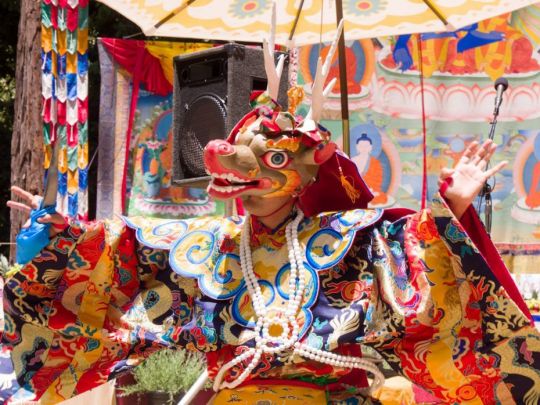
Tenzin Monlam performs the deer dance at Land of Medicine Buddha, Soquel, California, US, July 2017. Photo courtesy of Denice Macy.
Building projects manager Denice Macy at Land of Medicine Buddha (LMB) in California recently shared a useful how-to list for hosting a large-scale Dharma event:
In November 2002, Sally Barraud, then director of Land of Medicine Buddha, received advice from Lama Zopa Rinpoche to host a Medicine Buddha Festival at LMB at least once a year. Pearls of wisdom flowed from Rinpoche’s mouth—the advice of what to do, what to offer. With unwavering faith, Sally went to work with her team and the local community to host the first Medicine Buddha Festival. Sally reached out to Geshe Ngawang Drakpa from Tse Chen Ling in San Francisco, Ven. Donyo at Gyuto Vajrayana Center in the Bay Area, and Tam To, a local leader of the Vietnamese community in San Jose. Eight months later, the festival became a reality.
What follows is some practical advice that we have learned from hosting the Medicine Buddha Festival for the past fifteen years.
Before anything—go for refuge.
We are in service to our guru, who is at times, a hilarious comic. Have fun (Rinpoche does), laugh at mistakes (Rinpoche does), experience it all with compassion (Rinpoche does)! Buckle up and get ready for a fun and wild ride by hosting a large Dharma event to benefit others!
1. Identify the main purpose of your event.
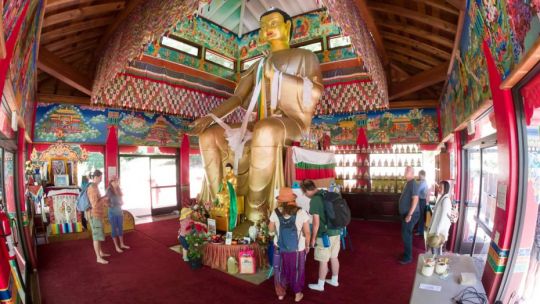
Wish Fulfilling Temple, Land of Medicine Buddha, Soquel, California, US, July 2017. Photo courtesy of Denice Macy.
This will be your guide as you organize your event. For LMB, the main purpose as advised by Rinpoche was and is to give as many people as possible the opportunity to take part in the Medicine Buddha puja, to learn about the Medicine Buddha, to provide people with the opportunity to make extensive offerings to please the Buddha, and the opportunity to create imprints and merit! Easy enough!
2. Plan well ahead!
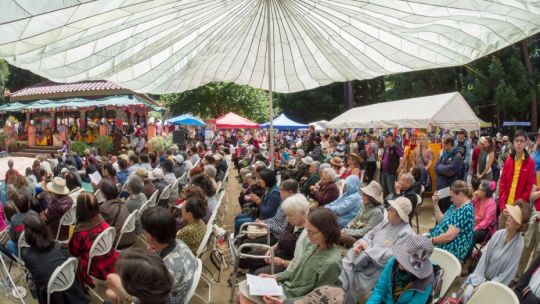
Attendees at the Land of Medicine Buddha festival in Soquel, California, US, July 2017. Photo courtesy of Denice Macy.
A successful LARGE event, Dharma or secular, needs to be planned well in advance. We look at dates as much as a year in advance. Some of the factors we consider include: the weather, dates of public holidays, seasonal events, other regularly scheduled festivals, and community events. If you fail to consider these factors, you may find that people who might benefit from your event are otherwise previously committed or that the weather is a bummer. Big party, big fun, big love!
3. Speaking of big, think BIG!
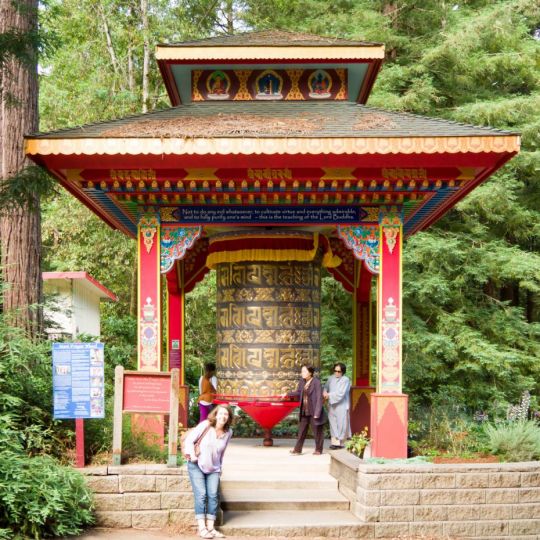
Mani prayer wheel at the Land of Medicine Buddha in Soquel, California, US, July 2017. Photo courtesy of Denice Macy.
Rinpoche helps us to identify how to please and benefit sentient beings. Consider the many different dispositions of sentient beings. Some people might attend because they love the delicious free food, others might have interest in the Tibetan culture, others want to connect with community, others have strong karmic connection to the Dharma, and some are looking for a wholesome family event—so provide varied opportunities. We have yet to provide pony rides around our stupa as Rinpoche requested, but it is in the plans! Not only would this benefit the ponies, but also the kids who would ride or lead them around the stupa.
4. Consider varied potential interest groups in your community.
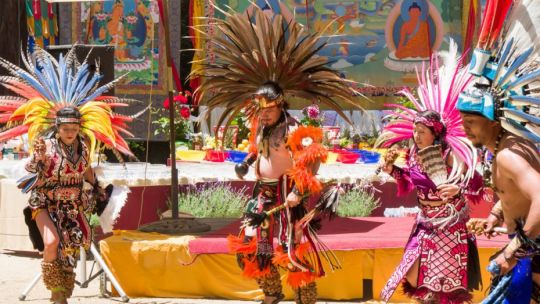
Sun Family Meixca Dance – Medicine Buddha Festival in Soquel, California, US, July 2017. Photo courtesy of Denice Macy.
Shine the Dharma light, spread your net wide. Let people know about your event; it is a priceless opportunity for you to connect and benefit others. We pay for advertising on the local public radio stations, in the weekly community newspaper, and sponsor adverts on Facebook. Don’t forget to take advantage of free media opportunities by sending out press releases to the local daily newspapers and online news sites, and using email messages and Facebook. We also print large posters that are placed at the center and email digital copies of them to our community connections.
5. Plan a non-sectarian Dharma event.

Tibetan dancers at the Medicine Buddha Festival in Soquel, California, US, July 2017. Photo courtesy of Denice Macy.
Don’t limit your audience. Rinpoche gave us the advice to invite all the area Dharma centers including Zen, mindfulness-based groups, Chinese, Vietnamese, and other Tibetan lineage centers. This is an opportunity to join with and welcome the diversity of our Dharma community. Of course, inviting other FPMT projects and centers is a must. Offer local FPMT family centers, projects, and services a table at your event to share information about their programs. Invite animal rescue groups or other non-profit organizations that align with benefiting sentient beings.
6. Re-read advice from Rinpoche on how to hold these large events.
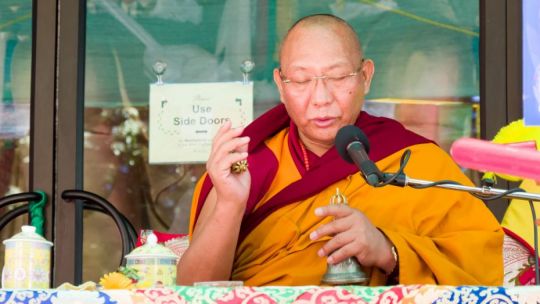
Dagri Rinpoche at the Land of Medicine Buddha Festival in Soquel, California, US, July 2017. Photo courtesy of Denice Macy.
Duh. Of course, none of us would intentionally ignore precious advice that we have received from Rimpoche. However, it is IMPORTANT to re-read advice (again, months in advance). You will likely find it is not possible to do everything Rinpoche advises right away, or even in the first few years of holding an annual event. You may find like us, however, that it is possible to add elements each year in a practical way. It took years for us to find Mongolian acrobats in our area, but eventually we did!
7. Practice generosity and pleasing sentient beings.
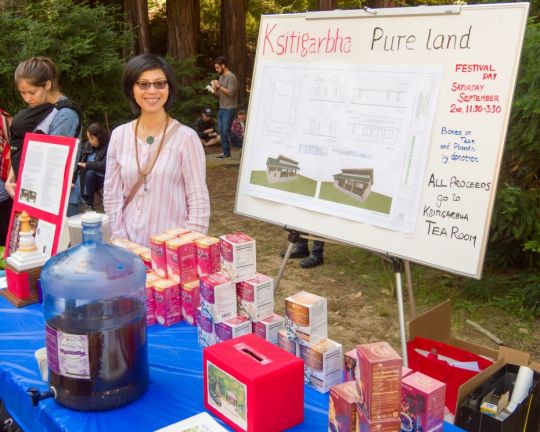
Fundraising and offering donations at the Medicine Buddha Festival, Soquel, California, US, July 2017. Photo courtesy of Denice Macy.
Make meaningful and generous offerings to the people who contribute to the day: festival t-shirts for volunteers, offerings of money and special treats to the Sangha, and generous offerings to those who make music or dance offerings. Here, remember to make as extensive offerings as possible on your altars, and give people an opportunity to sponsor those offerings. People from around the world who are unable to attend your event may have the wish to participate by sponsoring various offerings.
8. Support your team, meet, and follow up.
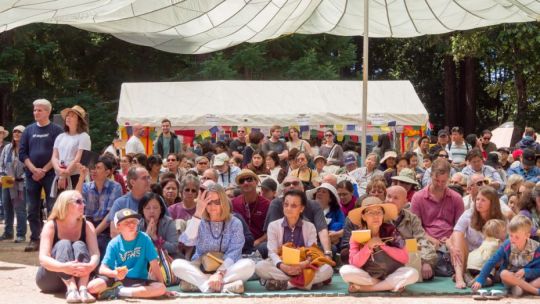
Attendees at the Medicine Buddha Festival in Soquel, California, US, July 2017. Photo courtesy of Denice Macy.
Even the most enthusiastic and reliable community members have obstacles that will arise. It is helpful to share information and to-do lists on Google Docs and other online methods of communication. Have a volunteer coordinator, logistics coordinator, liaison with performers, and parking coordinator. Make lists and meet in person with your team. Make plans to follow up so you can make adjustments as issues arise.
9. Remember that you may not have time in the last days before the event to do X, Y, or Z.
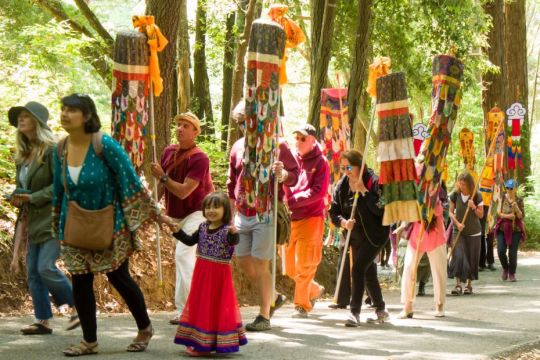
Parade at the Medicine Buddha Festival in Soquel, California, US, July 2017. Photo courtesy of Denice Macy.
Do it now! Funny things happen when making plans for Dharma events. One year in the middle of June, a large tree fell blocking the road to our center for more than twelve hours—the day before our event! Another year someone drove a car over a cliff. It is interesting to recall how obstacles can arise and surprise. If you leave things to the final days before an event, the stress level of your team may go through the roof. Do as much as you can now. Make lists with your team that can be completed well in advance. Leave a lot of space in the last few days to be surprised by things not going exactly as planned.
10. Trust your team!
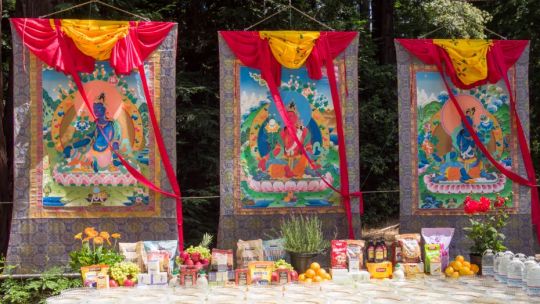
Three of the Eight Great Bodhisattvas, Land of Medicine Buddha, Soquel, California, US, July 2017. Photo courtesy of Denice Macy.
The mind that sees problems is persistent (speaking for myself here). Remember you have an amazing team with Rinpoche at the head; Rinpoche inspires us to stretch ourselves, and if we trust Rinpoche’s advice, we can move ahead with faith that we have the skill, team, and karma for a successful event. Though we are limited and may learn some uncomfortable lessons along the way, we are on the right path!
Read more about the festivities, spiritual programs, and life in the community at Land of Medicine Buddha: http://landofmedicinebuddha.org/
FPMT.org and Mandala Publications brings you news of Lama Zopa Rinpoche and of activities, teachings and events from over 160 FPMT centers, projects and services around the globe. If you like what you read, consider becoming a Friend of FPMT, which supports our work.
- Tagged: festival days, land of medicine buddha
8
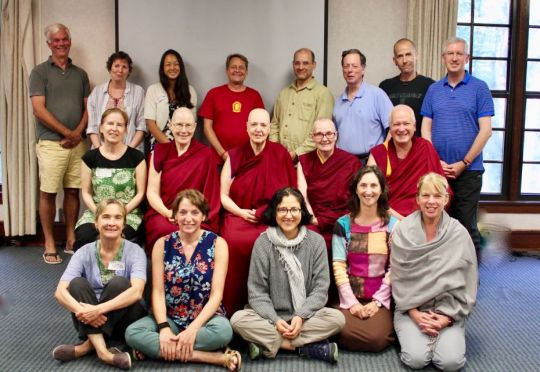
Participants of the FPMT North America Regional Meeting during the Light of the Path retreat in Black Mountain, North Carolina, US, August 2017. Photo courtesy of Drolkar McCallum.
In August 2017, Drolkar McCallum, regional coordinator for FPMT North America and member services coordinator for the International Mahayana Institute—FPMT’s international community of nuns and monks—visited Black Mountain, North Carolina, United States, for the Light of the Path (LOP) retreat. During the retreat, which was led by Lama Zopa Rinpoche, FPMT North America held a successful and highly enjoyable regional meeting. Droklar offered her reflections:
FPMT North America held a successful and enjoyable regional meeting over August 22 and 23 during the Light of the Path (LOP) retreat in Black Mountain, North Carolina.
Twenty-two participants representing International Office and a group of twelve centers, projects, services, and study groups from all over the US and Canada came together with a few registered teachers to discuss revenue generation, live streaming, grievance procedures, and the importance of International Sangha Day.
There was an informative presentation given by Annelies van der Heijden from Maitreya Instituut in the Netherlands on the immense value of the Foundation Service Seminars. Jill Marie from Kadampa Center spoke about fundraising; Tom Truty spoke about the current projects of Education Services; and I outlined the importance of moving forward in FPMT’s regionalization strategy in order to fulfill Lama Zopa Rinpoche’s wishes for the organization.
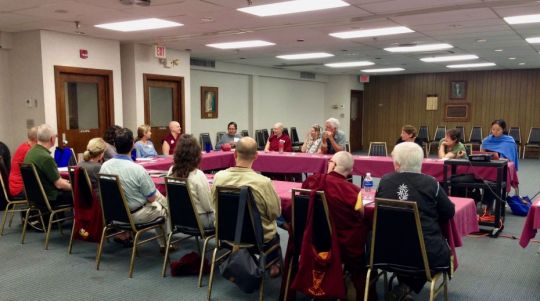
FPMT North America Regional Meeting during the Light of the Path retreat in Black Mountain, North Carolina, US, August 2017. Photo courtesy of Drolkar McCallum.
Even though the meeting was shorter than normal, one benefit of having it at the beginning of LOP is that people were introduced to each other at the start and then had plenty of time and opportunity during the retreat to get together and discuss other issues and do some mutually beneficial brain showering!
The greatest advantage, of course, is that our most precious guru, Kyabje Lama Zopa Rinpoche, was nearby and his blessings caused great inspiration, creativity, and a willingness to get more involved.
FPMT.org and Mandala Publications brings you news of Lama Zopa Rinpoche and of activities, teachings, and events from over 160 FPMT centers, projects, and services around the globe. If you like what you read, consider becoming a Friend of FPMT, which supports our work.
3
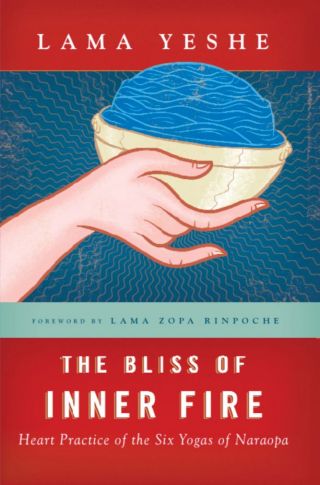
“We only started carrying ebooks in 2015, starting with Lama Yeshe Wisdom Archive’s titles. In 2016, Editions Mahayana and Ediciones Dharma agreed to let us host their French and Spanish titles, respectively. And now in 2017, Wisdom Publications worked with us to find a way to carry its titles, like Lama Zopa Rinpoche’s How to Enjoy Death and Lama Yeshe’s The Bliss of Inner Fire, too. There are even some ebooks that are only available by donation, such as Tenzin Ösel Hita’s Do Not Believe Everything You Think.
“Forty percent of our customers live outside of the United States so it was important to spread Dharma while bringing shipping costs to zero. Fewer print copies means we potentially make less of an impact on global forests, which is something really important to me. Also, I really hope that more young people engage with Buddhism, and since they are into digital devices of all kinds, making popular titles available in ebook format is one way to encourage that. I’m really pleased with the progress we’ve made in this area so far.”
Check out the Foundation Store’s 108 ebook titles today:
https://shop.fpmt.org/View-All-eBooks_c_551.html
Mandala brings you news of Lama Zopa Rinpoche and of activities, teachings, and events from over 160 FPMT centers, projects and services around the globe. If you like what you read in Mandala, consider becoming a Friend of FPMT, which supports our work.
- Tagged: ebooks, foundation store
1

His Holiness the Dalai Lama with devotees in Palermo, Sicily, Italy, September 2017. Photo by Ugo Gorvaia.
This September, His Holiness the Dalai Lama took a short tour of the Italian island of Sicily. During a visit to the town of Palermo, His Holiness was awarded the status of “Honorary Citizen” by the mayor, Professor Lealuca Orlando.
The brief presentation took place at the Teatro Massimo, the venue for a talk in which His Holiness addressed the subject of peace and the meeting of peoples. The talk, in front of 1,400 attendees, took place ahead of a smaller gathering of media and Italian students at His Holiness’s hotel.
Centro Muni Gyana students Fabio Gariffo and Grazia Asaro were in attendance at the theater and hotel. They recorded their experiences:
At the hotel, His Holiness addressed the practitioners from Centro Muni Gyana, saying, “And now I want to speak with the group of Lama Zopa.”
The center, established in 2009, occupies a villa that local authorities confiscated from the mafia. To this audience of students, whose center is housed in a building that has changed purpose with the times, His Holiness spoke on the importance of studying Buddhism with an evolving, modern perspective.
His Holiness remarked that when he teaches in Europe or in the United States, he has no interest in proselytizing. However, he emphasized that understanding the function of mind and emotions, a study that Tibetan Buddhism has inherited and preserved from the Nalanda tradition, is very valuable and useful for everyone. He added that many people wish to study the tradition of Nalanda, brought to Tibet from India in the 8th century by the great scholar, philosopher, psychologist, and logician Shantarakshita. It can be said that authentic Buddhism, the one based on logical reason, was imported by him, and that Tibetans are the only ones who have fully maintained this ancient tradition.
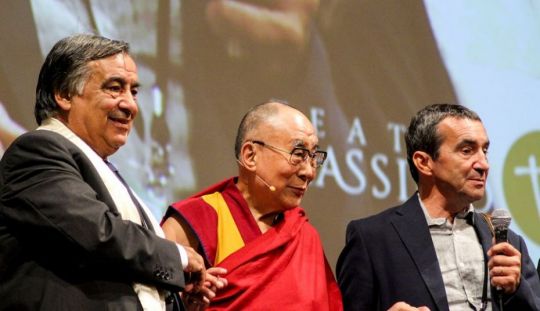
His Holiness the Dalai Lama at the Teatro Massimo in Palermo, Sicily, Itlay, September 18, 2017. Photo courtesy of Centro Muni Gyana.
“The Buddha himself,” continued His Holiness, “has recommended not to follow blindly his teachings, but to analyze them and to examine their effectiveness in our own experience. This analytic spirit is the most useful way to embrace the Buddhist teachings.
“The scientists I periodically meet are very amazed by the depth of the intuitions of Nalanda’s scholars. Let me say that modern psychology is far from the science of mind that comes from this ancient monastic university. For this reason, the bases of this tradition are necessary, and there is a great benefit in their integration with Western subjects of study such as psychology and quantum physics.
“For about forty years I have made great changes within the Tibetan community, emphasizing that the most important thing is not the rituals, but the study of the texts—a message that is also valid for the nunneries, where today it’s possible to obtain the complete curriculum of thirty years of study required to become a geshe. Therefore, Dharma centers must be, first of all, academies and centers of study.
“So in your center, even if it’s small, you must consider yourself students! I’m eighty-two and I still consider myself a student.”
“In this way,” he concluded, “we can contribute to society. Today there is a great emotional crisis all over the world and this secular knowledge can make a big contribution toward eliminating it.”
Read more about Centro Muni Gyana:
http://centromunigyana.it/
FPMT.org and Mandala Publications brings you news of Lama Zopa Rinpoche and of activities, teachings, and events from over 160 FPMT centers, projects, and services around the globe. If you like what you read, consider becoming a Friend of FPMT, which supports our work.
27
Istituto Lama Tzong Khapa (ILTK) in Pomaia, Italy, is currently hosting the month-long 100 Million Mani Retreat, guided by Lama Zopa Rinpoche. From October 4 to November 5, hundreds of participants will collectively recite OM MANI PADME HUM, the mantra of Chenrezig (Avalokiteshvara), the Buddha of Compassion, 100 million times.
Students from all over the world are in attendance, including one person who has perhaps traveled further than most. Paul, a New Zealander who arrived in Italy by way of Australia, told one of the retreat organizers about his motivation behind the journey all the way from the southern hemisphere and his experience of the retreat so far. Here’s the story:
You are from New Zealand and you live in Australia, what made you come all the way up here?
Paul: I consider Lama Zopa Rinpoche as my main teacher, the one I have a connection with. Recently, I had the feeling that I should spend more time in front of him. Fortunately, I could be away from work for the entire month of October.
Have you already attended teachings, initiations, or retreats with Lama Zopa Rinpoche?
Yes. I was at the Great Chenrezig retreat at Chenrezig Institute and the Medicine Buddha retreat in Adelaide, both in Australia. Besides, I did the Kopan November course once.
Have you seen some of your fellow students from Kopan?
Oh, yes. I met quite a few of them again. It feels like after a wedding. One finds again friends sharing one’s same experience or sharing common friends.
Can you say that there is a kind of Kopan community? Do you find it supportive?
It is nice to know that you have friends around the world following a similar path. It gives me a feeling of interconnectedness.
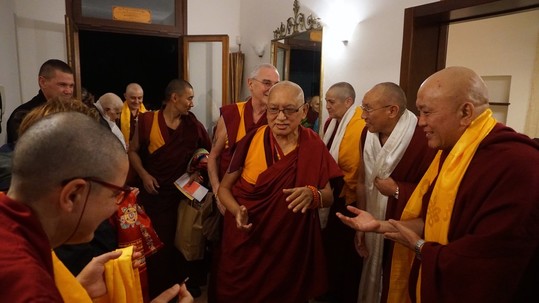
Lama Zopa Rinpoche arriving at Istituto Lama Tzong Khapa, Italy, October 2017. Photo by Ven. Lobsang Sherab.
For more information on the 100 Million Mani Retreat and the programs offered at Istituto Lama Tzong Khapa visit:
https://www.iltk.org/
You can watch Lama Zopa Rinpoche teach live from the 100 Million Mani Mantra Retreat on YouTube and Facebook. For links and details:
https://fpmt.org/media/streaming/lama-zopa-rinpoche-live/
More information, photos, and updates about FPMT spiritual director Lama Zopa Rinpoche can be found on Rinpoche’s webpage on FPMT.org. If you’d like to receive news of Lama Zopa Rinpoche and FPMT via email, sign up to FPMT News.
13

The candlelight procession of the opening ceremony, Sakyadhita International Conference, Hong Kong, June 2017.
In June 2017, Drolkar McCallum, regional coordinator for FPMT North America and member services coordinator for the International Mahayana Institute—FPMT’s international community of nuns and monks—visited Hong Kong to attend the Sakyadhita International Conference. Drolkar, who additionally serves as acting president of Sakyadhita Canada, shared experiences from the six-day event:
The fifteenth conference of the Sakyadhita International Association of Buddhist Women, held at the University of Hong Kong from June 22 to 28, was attended by over 800 Buddhist nuns and laywomen from thirty-one countries!
The name Sakyadhita means “Daughter of Shakya,” harkening back to the clan name of the historical Buddha. Sakyadhita International is an alliance of women and men whose goal it is to empower the world’s 300 million Buddhist women to work for peace and social justice and to advance their spiritual and secular lives.
They hold an international conference every two years, the first of which was held in Bodhgaya, India, in 1987. This year celebrated Sakyadhita’s thirty-year anniversary with the theme, “Contemporary Buddhist Women: Contemplation, Cultural Exchange & Social Action.”
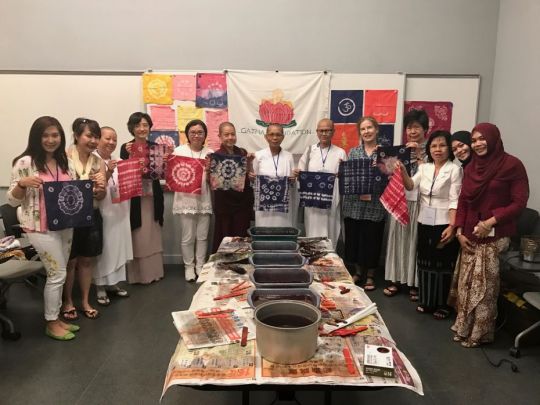
Batik Making Workshop at the Sakyadhita International Conference in Hong Kong. Photo by Drolkar McCallum.
For one week laywomen, nuns, laymen, and monks from many different nations and backgrounds gathered in harmony to share their ideas and experiences. The program included a rich mixture of panel presentations, workshops, Dharma talks, meditations, chanting, and cultural performances. At the end, there was a two-day tour of several Buddhist sites around Hong Kong.
The conferences, held in different, usually Buddhist, countries aim to bring together scholars, monastics, and members of the public to forge pathways forward for the interests and needs of Buddhist women around the world. Its primary purpose is to promote world peace through the practice of the Buddha’s teachings.
In the opening ceremony on the first day, Jetsunma Tenzin Palmo, who is president of Sakyadhita International, and Ven. Karma Lekshe Tsomo, who is co-founder and the event organizer, gave short but inspiring welcoming speeches in the vast Grand Hall of the university.
Jetsunma emphasized that the conference aims to empower laywomen and monastics around the world and to bridge scholars and practitioners. It also shares practices such as loving kindness, thereby helping to bring peace and wisdom into the world.
She also expressed the hope that this year’s meeting could serve as a bridge, strengthening the connection between East and West. She emphasized that the conference celebrates the achievements of both monastic and lay Buddhist women, but also stressed that even though the conference was about women, it is certainly not anti-men, and that all the lay and monastic men present were most welcome!
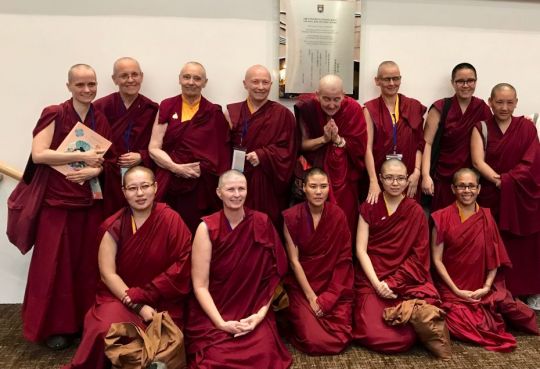
Nuns from the Tibetan Buddhist tradition at the conference, including Jetsunma Tenzin Palmo and Ven. Karma Lekshe Tsomo. FPMT IMI nuns are Vens. Lozang Drolkar from Australia and Tenzin Lekdron from Sri Lanka. Missing from the photo is Ven. Lozang Tseten also from Australia. Photo by Drolkar McCallum.
The last day started with more than twenty focus groups on such topics as social engagement, justice, the future of Sakyadhita International, science and Buddhism, and monastic training in East and West. Most of the Western nuns joined the focus group on monastic training. Jetsunma Tenzin Palmo shared about the difficulties of Western nuns, particularly the lack of financial support from their Tibetan teachers and from lay people. She brought up examples of monastics who have not been treated well or lived under difficult circumstances although contributing greatly to the developments of Buddhist centers.
Ven. Jampa from Sravasti Abbey in the United States mentioned: “This topic of support for nuns came up throughout the conference. I learned quite a bit, especially during the discussions and sharing, not just about the lack of support for Western Buddhist nuns in the Tibetan tradition, but also about the cultural gap between East and West in that regard. Westerners still tend to support their spiritual Tibetan teachers and Tibetan monastics in exile more than the Western monastics of the Tibetan traditions, even though the nuns help their Buddhist centers, teachers, and many students. Few Western monastics who either live in Asia, work in Western Dharma centers, or who have supported their Tibetan teachers receive financial support in return.”
During the breaks and meal times, I participated in valuable discussions with nuns and laywomen from all over the world and all traditions. We discussed a wide range of topics from reviving full ordination for nuns, building monasteries, support and training for Westerners, and even FPMT International Sangha Day!
It was indeed a unique and rich celebration of all Buddhist traditions coming together to better understand, help support, and appreciate each other.
Read more about the work of Sakyadhita International and find a review of the Hong Kong conference: http://www.sakyadhita.org/
Support ordained Sangha—women and men—through the Supporting Ordained Sangha Fund:
https://fpmt.org/projects/fpmt/supporting-ordained-sangha-fund/
FPMT.org and Mandala Publications brings you news of Lama Zopa Rinpoche and of activities, teachings, and events from over 160 FPMT centers, projects and services around the globe. If you like what you read, consider becoming a Friend of FPMT, which supports our work.
- Home
- News/Media
- Study & Practice
- About FPMT Education Services
- Latest News
- Programs
- New to Buddhism?
- Buddhist Mind Science: Activating Your Potential
- Heart Advice for Death and Dying
- Discovering Buddhism
- Living in the Path
- Exploring Buddhism
- FPMT Basic Program
- FPMT Masters Program
- FPMT In-Depth Meditation Training
- Maitripa College
- Lotsawa Rinchen Zangpo Translator Program
- Universal Education for Compassion & Wisdom
- Online Learning Center
- Prayers & Practice Materials
- Overview of Prayers & Practices
- Full Catalogue of Prayers & Practice Materials
- Explore Popular Topics
- Benefiting Animals
- Chenrezig Resources
- Death & Dying Resources
- Lama Chopa (Guru Puja)
- Lama Zopa Rinpoche: Compendium of Precious Instructions
- Lama Zopa Rinpoche: Life Practice Advice
- Lama Zopa Rinpoche Practice Series
- Lamrim Resources
- Mantras
- Prayer Book Updates
- Purification Practices
- Sutras
- Thought Transformation (Lojong)
- Audio Materials
- Dharma Dates – Tibetan Calendar
- Translation Services
- Publishing Services
- Teachings and Advice
- Find Teachings and Advice
- Lama Zopa Rinpoche Advice Page
- Lama Zopa Rinpoche: Compendium of Precious Instructions
- Lama Zopa Rinpoche Video Teachings
- ༧སྐྱབས་རྗེ་བཟོད་པ་རིན་པོ་ཆེ་མཆོག་ནས་སྩལ་བའི་བཀའ་སློབ་བརྙན་འཕྲིན།
- Podcasts
- Lama Yeshe Wisdom Archive
- Buddhism FAQ
- Dharma for Young People
- Resources on Holy Objects
- Ways to Offer Support
- Centers
- Affiliates Area
- Teachers
- Projects
- Charitable Projects
- Make a Donation
- Applying for Grants
- News about Projects
- Other Projects within FPMT
- Support International Office
- Projects Photo Galleries
- Give Where Most Needed
- FPMT
- Shop
Subscribe to FPMT News
Translate*
*powered by Google TranslateTranslation of pages on fpmt.org is performed by Google Translate, a third party service which FPMT has no control over. The service provides automated computer translations that are only an approximation of the websites' original content. The translations should not be considered exact and only used as a rough guide.Every second of this human life gives us the freedom to choose between hell and enlightenment, samsara and liberation.






